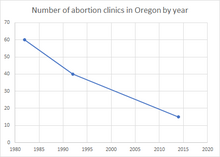Abortion in Oklahoma is illegal unless the abortion is necessary to save the life of a pregnant woman.
Abortion in Arkansas is illegal except when it is necessary to save the life of the mother. Doctors determined to have performed an abortion face up to 10 years in prison and fines up to $100,000.
Abortion in Delaware is legal up to the point of fetal viability. 55% of adults said in a poll by the Pew Research Center that abortion should be legal and 38% stated it should be illegal in all or most cases. There was a therapeutic exceptions in the state's legislative ban on abortions by 1900. Informed consent laws were on the books by 2007. In 2017, Senator Bryan Townsend, D-Newark introduced legislation to try to make clear that abortion would remain legal in the state in case 1973's Roe v. Wade ruling was overturned. The legislation was subsequently updated. Attempts have been made to introduce mandatory ultrasound laws, but they failed to get out of committee. State legislators tried to move ahead the week at which a woman could get a legal abortion in 2019.
Abortion in Hawaii is legal. 66% of adults in Hawaii said in a poll by the Pew Research Center that abortion should be legal in all or most cases. Hawaii began allowing elective abortion care de jure in 1970, the first state to do so. State law enacted at that time stated said, "the State shall not deny or interfere with a female's right to choose or obtain an abortion of a nonviable fetus or an abortion that is necessary to protect the life or health of the female."
Abortion in Idaho is illegal from fertilization. Following the overturning of Roe v. Wade on June 24, 2022, abortion in Idaho was criminalized by the trigger law which states that a person who performs an abortion may face two to five years of imprisonment. The ban allows exceptions for maternal health, rape and incest within the first trimester. The law took effect on August 25, 2022.
Abortion in Maine is legal, although terminations after fetal viability can only be performed if a physician determines it to be medically necessary. According to a poll by the Pew Research Center, 64% of adults said that abortion should be legal, with 33% stating that it should be illegal in all or most cases.
Abortion in Minnesota is legal at all stages of pregnancy. The Minnesota Supreme Court ruled the Minnesota Constitution conferred a right to an abortion in 1995 and the DFL-led Minnesota Legislature passed and Minnesota Governor Tim Walz signed into law a bill in 2023 to recognize a right to reproductive freedom and preventing local units of government from limiting that right, making Minnesota the first state in the nation in the post-Roe era to ensure residents have a legal right to an abortion.
Abortion in Montana is legal. The number of abortion clinics in Montana has fluctuated over the years, with twenty in 1982, twelve in 1992, eight providers of which seven were clinics in 2011, and five clinics in 2014. There were four clinics from 2015 to February 2018 when All Families Healthcare clinic in Whitefish reopened. There were 1,690 legal abortions in 2014, and 1,611 in 2015.
Abortion in Nebraska is legal up to the 12th week of pregnancy, after new legislation was signed in May 2023. In June 2023, a lawsuit was filed to challenge the state's abortion law. The legislation establishing the law contained provisions concerning both abortion and gender-affirming care, while the state constitution prohibits bills that legislate on multiple issues at once.
Abortion in Nevada is legal up to the 24th week of pregnancy, under the Nevada Revised Statutes chapter 442, section 250; and after 24 weeks if the pregnancy could be fatal for the pregnant woman. 62% of adults said in a poll by the Pew Research Center that abortion should be legal while 34% said it should by illegal in all or most cases. Legislation by 2007 required informed consent. Attempts were successfully made to pass abortion legislation in May 2019, being pushed through a largely Democratic controlled state legislature. The number of abortion clinics in Nevada has declined over the years, with 25 in 1982, seventeen in 1992 and thirteen in 2014. There were 8,132 legal abortions in 2014, and 7,116 in 2015. Due to the high level of support for abortion rights, continued access to abortion is supported by all parties, including the Republicans.
Abortion in North Dakota is illegal. The state's sole abortion clinic relocated to Minnesota.
Abortion in Rhode Island is legal. On June 19, 2019, the legal right to abortion was codified into Rhode Island law by passage of the Reproductive Privacy Act.
Abortion in South Dakota is illegal. Anyone who induces an abortion is guilty of a Class 6 felony. An exception is included to "preserve the life of the pregnant female," given appropriate and reasonable medical judgment.
Abortion in Tennessee is illegal from fertilization, except to "prevent the death of the pregnant woman or to prevent serious risk of substantial and irreversible impairment of a major bodily function of the pregnant woman".
Abortion in Utah is legally performed under a temporary restraining order blocking enforcement of the state's trigger law, which bans abortion. According to HB136, which is effective state law from June 28, 2022, abortions are banned following 18 weeks of gestation. Abortion was banned following the Supreme Court case, Dobbs v. Jackson Women's Health Organization on June 24, 2022. Utah State Legislation enacted SB 174 in May 2020, which, upon the overturn of Roe v. Wade, made inducing an abortion a second-degree felony. The law includes exceptions for pregnancies "caused by rape or incest," pregnancies that put the mother's life at risk, or "if two doctors say the fetus has a lethal defect." Rape and incest exceptions will only be viable if the crimes were previously reported to law enforcement officials.
Abortion in Vermont is legal at all stages of pregnancy. A 2014 Pew Research Center poll showed 70% of adults in the state believed abortion should be legal in most or all cases, the second highest percentage in the country. The state funds abortions deemed medically necessary for low-income women via Medicaid.
Abortion in the U.S. state of Virginia is legal up to the end of the second trimester of a pregnancy. Before the year 1900, abortion remained largely illegal in Virginia, reflecting a widespread trend in many U.S. states during the 19th and early 20th centuries. Abortion was viewed as a criminal act and subject to state laws that prohibited it. However, by 1950, Virginia introduced a legal therapeutic exception, allowing for abortion under specific circumstances, primarily when a woman's physical or mental health was at risk. Notably, the University of Virginia Hospital established a review board in 1950 responsible for evaluating and approving abortion requests, particularly those grounded in psychiatric reasons. This thorough approval process resulted in a significant decrease in the number of abortions performed at the hospital.
Abortion in Washington is legal up to the point of fetal viability, or in case the pregnancy poses a risk to life or health. In a poll by the Pew Research Center, 60% of adults said that abortion should be legal in all or most cases.
Abortion in West Virginia is illegal except in cases of rape, incest, fatal fetal abnormalities, and when the mother’s life is at risk from a pregnancy.
Abortion in New Mexico is legal at all stages of pregnancy. The number of abortion clinics in New Mexico has declined over the years, with 26 in 1982, 20 in 1992 and 11 in 2014. There were 4,500 legal abortions in 2014. There were 7 facilities providing abortion in New Mexico in 2017, and 6 of those were clinics. In 2017, 91% of New Mexico counties had no clinics that provided abortions, and 48% of New Mexico women lived in those counties.

